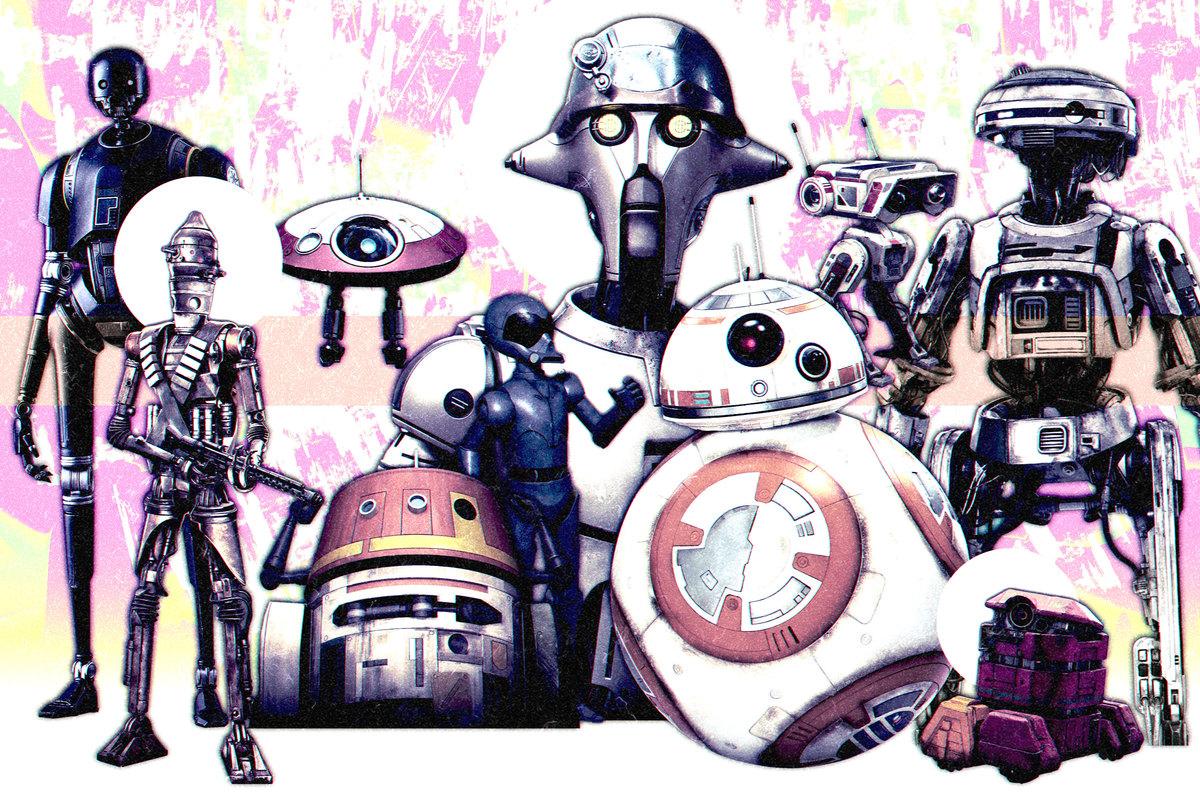
Ahsoka started slow, but the latest Star Wars series on Disney+ is coming off back-to-back bangers. This week’s “Shadow Warrior” was an eagerly anticipated showcase for Hayden Christensen’s Anakin Skywalker; a poignant treat for fans who’ve followed Anakin and Ahsoka’s on-screen interactions for 15 years; and a visual tour de force featuring lightsabers, starfighters, and space whales. Naturally, then, the most memorable line—in my mind, at least—is delivered by a droid whose prominence in the series is something of a surprise.
“I told them to stay together,” laments Huyang, the ancient Jedi droid who’s acting as Ahsoka’s sidekick, referring to Ahsoka and her apprentice, Sabine Wren. “But they never listen. They never listen.” Huyang, who helped train younglings for more than a thousand generations, has lived—well, remained in operation—to see almost all of those young Jedi perish. The order he served has been destroyed. And when he makes this pronouncement—which shakes General Hera Syndulla—Ahsoka and Sabine are missing. Huyang has seen these separations play out countless times. He knows how often they end in tragedy. He can’t convey his dismay with tears or frowns. Yet the bowing of his head, the dimming of his photoreceptors, and the catch in his vocoder convey the horror of what he and the Jedi have endured. The scene is as moving as Ahsoka’s flashbacks, Anakin’s shape-shifting, or Baylan’s allusions to the legacy of “death and destruction” that Ahsoka has inherited.
Later, Huyang leaves Hera speechless a second time with his heartwarming, matter-of-fact assessment of her rebellious streak: “You do things your way because you care. That is why people like you.” Huyang has the funniest exchange in the mostly serious episode, too, when he agrees to give Hera’s son, Jacen, a tour of Ahsoka’s shuttle:
Huyang: Come along. I’ll show you the training room.
Jacen: You have a training room in your starship? Will you train me?
Huyang: No.
Jacen: Do you know how to build a lightsaber?
Huyang: Yes.
Jacen: Will you teach me?
Huyang: No.
Throughout the series, the droll droid has done it all: given guidance, dispensed details, lightened the mood. Even in the weakest episode, “Time to Fly,” Huyang was a highlight, laying out the lineage of “nontraditional Jedi” Ahsoka belongs to and becoming comic relief when Ahsoka uses his “standard Jedi protocol” line to talk him into shutting down, which makes him miss out on a purrgil-pod sighting. Ahsoka owes Huyang her life—he saves her in her first action sequence of the series—and when Ahsoka’s ship enters the purrgil’s maw at the end of this week’s episode, Huyang is at the controls. Ahsoka also owes her presence at Huyang’s side to a different droid: Hera’s bratty astromech, Chopper, who helps save Ahsoka earlier in “Shadow Warrior” by pinpointing the location of her unconscious, submerged body.
Huyang has been a breakout character, but perhaps his fan-favorite status should have been foreseeable. Stealing—or at least sharing—the spotlight has been par for the course in the droid department throughout the recent explosion in on-screen Star Wars content. Star Wars during the Disney era has been brilliant, embarrassing, and everything in between—sometimes within the same trilogy, series, or season. (As was Star Wars in the latter days of George Lucas’s control.) Ahsoka has been a bit uneven, too, but its droids, like those of the franchise at large, have been consistent strengths. Say what you will about the franchise’s fluctuations in quality over the past several years, but even under Disney, Star Wars droids don’t miss. They’re almost always the ones we’re looking for.
Star Wars has been a droid-centric saga from the start—as in, the very first scene. R2-D2 and C-3PO are the only characters to appear in all nine films of the three theatrical trilogies (in addition to their cameo in Rogue One). Threepio utters the first line in the original trilogy—which he repeats, verbatim, toward the end of The Rise of Skywalker—and the last line in the prequels. And in 2005, Lucas justifiably labeled Artoo “clever and ultimately the hero of the whole piece. He’s the Lassie of the movies: Whenever there’s a pivotal moment of real danger, he’s the one that gets everybody out of it.” Supposedly, Lucas envisioned R2-D2 as the narrator of the Skywalker saga.
The franchise’s iconic droid duo, inspired by bickering peasants Tahei and Matashichi from Akira Kurosawa’s The Hidden Fortress, have continued to pop up in Disney-era movies, TV shows, video games, books, and comics. But they’ve been joined—and in some senses, supplanted—by a deep bench of endearing, distinctive, and memorable robots of a more recent vintage. Virtually every Star Wars screen project has its own standout droid (or droids), some of whom have helped expand the narrative range of the mechanical characters Wuher wouldn’t serve.
Some recent Star Wars droids are defined by their cuteness—and, in turn, their potential for toy sales. Some Star Wars droids were cute in the pre-Disney days—pit droids, mouse droids, gonk droids, Artoo, and QT-KT (a.k.a. “Qutee”)—but the cuteness factor has really ramped up of late. BB-8, Poe Dameron’s plucky all-terrain astromech from The Force Awakens and its sequels, was a spiritual successor to Artoo who rolled right into fans’ hearts and onto kids’ holiday wish lists. Years before Grogu reproductions reached shelves, BB-8 became a retail sensation. Other recent droids whose cuteness is their superpower include BB-9E, BB-8’s evil counterpart from The Last Jedi; D-O, BB-8’s formerly mistreated, stuttering friend from The Rise of Skywalker; L0-LA59 (a.k.a. “Lola”), little Leia’s companion from Obi-Wan Kenobi; and BD-1, Cal Kestis’s comrade from Jedi: Fallen Order and Jedi: Survivor.
Of course, cuteness and competence aren’t mutually exclusive. BB-8 is brave and daring. BD-1, who accompanies playable protagonist Cal throughout his interactive adventures, established himself as one of the franchise’s best droids ever by merging BB-8’s cuteness, Artoo’s utility, and Chopper’s attitude. Because BD-1’s almost always on-screen and serves so many functions, he’s an indispensable part of the player’s experience. And Chopper’s high jinks notwithstanding, he’s a full-fledged, highly valued member of the Spectre crew in Rebels.
All of the “cute” droids have something in common with Artoo: They don’t speak a language the audience understands, suggestive beeps and whistles aside. The language barrier and absence of subtitles limit viewers’ capacity to connect with them as complex characters. C-3PO, as he often notes, is fluent in over 6 million forms of communication, but he’s largely played for laughs (with some exceptions). By contrast, the Disney era’s greatest contribution to Star Wars droid-dom is its wealth of droids whose words and actions can coax tears as easily as laughs.
That’s not to say that recent Star Wars droids with significant speaking parts aren’t also funny. See, for instance, ex-Imperial protocol droid AP-5, the Marvin the Paranoid Android–esque C-3PO equivalent to Chopper’s R2-D2 in Rebels. Huyang is hilarious, as are K-2SO and L3-37 in prequel films Rogue One and Solo, respectively. Droids’ deadpan deliveries and decidedly nonorganic ways of looking at the world make them rich in comedic potential, and not just in a juvenile battle-droid way.
But some of those droids, and others, have proved capable of pathos that previous Star Wars droids rarely, if ever, achieved. C-3PO may have his head screwed on backward or attached to a battle droid’s body, and R2-D2 may short-circuit or shut down, but we know they’ll both be OK. That’s not the case with K-2SO, who sacrifices himself to save Jyn Erso and Cassian Andor, or L3-37, whose physical form was destroyed in combat, or medical droid AZI-3, who puts himself in harm’s way to save Omega in The Bad Batch, or the reprogrammed IG-11, who self-destructs in the Season 1 finale of The Mandalorian so that the good guys can get away, or B2EMO, the beloved, run-down droid whose toppling at the hands of the Empire is the last straw that sets off the revolt on Ferrix. Andor inspires a rich mix of emotions, but B2EMO’s mourning of Maarva may be the series’ saddest development.
It hasn’t hurt that Disney’s approach to live-action droids favors practical effects over VFX, and also prioritizes anthropomorphic expressiveness. Most modern Star Wars droids, unlike Threepio and Artoo, aren’t physically played by a person inside a suit or tin can—shout-out to Anthony Daniels and the late Kenny Baker—but they’re brought to life (or some simulacrum of life) by talented designers, puppeteers, and actors. Huyang is voiced by David Tennant; K-2SO by Alan Tudyk; IG-11 by Taika Waititi; and L3-37 by Phoebe Waller-Bridge (who also wore a motion-captured costume). Hell, BB-8 speaks in binary, but his beeps and boops were partly generated by Bill Hader and Ben Schwartz. Disney’s Star Wars droids sometimes seem more human than their flesh-and-blood scene partners.
This combination of arresting, convincing visuals and irreverent humor makes the new generation of Star Wars droids indelible. A few of the aforementioned droids have strong claims to be the best characters from their respective projects. (The absence of a slam-dunk droid unique to The Book of Boba Fett—apologies to that cool kitchen droid—arguably was one factor in that spinoff’s failure to make a more lasting impression.) Time after time, Disney Star Wars series have invented original droids, ported and expanded existing droids or droid concepts from other media—like The Mandalorian’s Dark Troopers, or Huyang, who leaped from animation in The Clone Wars to live action in Ahsoka—or given larger roles to preexisting characters, such as AZI-3 (who debuted in The Clone Wars) or R5-D4 (who was first briefly glimpsed in Episode IV). Even recent Star Wars literature has gotten in on the act, contributing well-received droids such as Mister Bones from the Aftermath novels and Triple-Zero and BT-1 from the 2015 Darth Vader comics—all murderous droids in the HK-47 tradition. (Yes, Star Wars droids can be cute, but they can also be scary.)
There’s still some room for Star Wars droids to diversify and grow. Star Wars isn’t hard sci-fi, and the franchise rarely reckons with philosophical questions about human-cyborg relations; anti-droid discrimination; the fine lines between service and servitude and artificial intelligence and sentience; and whether droids are completely cut off from romance or the Force. L3-37 raised some of those issues, as has Charles Soule’s Dark Droids comic. But I would welcome a mainstream Star Wars series that treated deactivating droids against their will as an affront to their autonomy, not as a punch line. Until Ahsoka, Star Wars stayed away from nonhuman protagonists; the next narrative frontier could be non-humanoid and droid protagonists. We’ve seen a few droid-centric episodes, such as Rebels’ “Double Agent Droid,” but maybe it’s time for a droid to be the star. I would watch Huyang.
On balance, droids have probably been the best aspect of the past decade of Star Wars—one area in which latter-day Star Wars has unquestionably equaled or surpassed the halcyon stories that are steeped in nostalgia. Ahsoka has extended that streak. “Is that a note of fear in your voice?” Morgan Elsbeth asks Baylan in Ahsoka Episode 4. “Experience,” he answers. Considering the cohort of tragically destroyed or reassembled droids in other recent Star Wars TV tales, I’m experiencing a similar apprehension. There are three more episodes of Ahsoka, and few characters are 100 percent certain to survive. But most of all, I fear for the one who has 75 percent of his original parts. Hang in there, Huyang.


